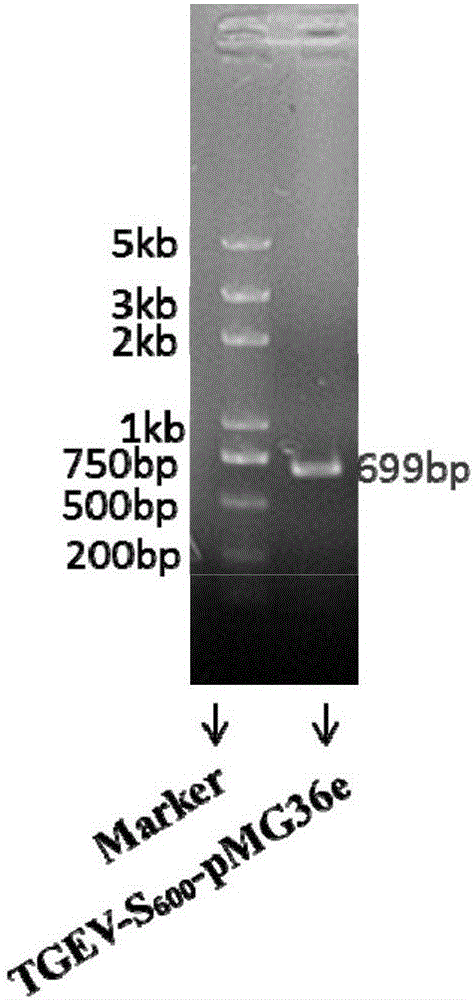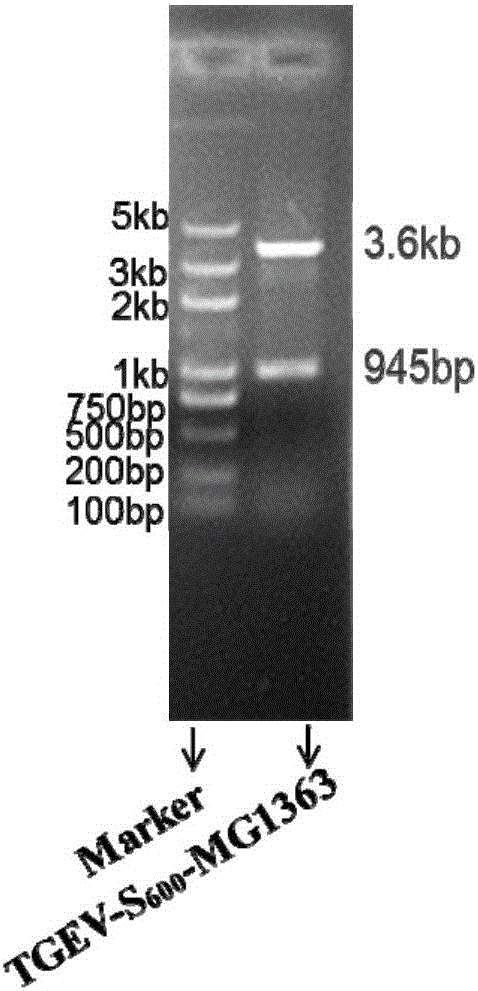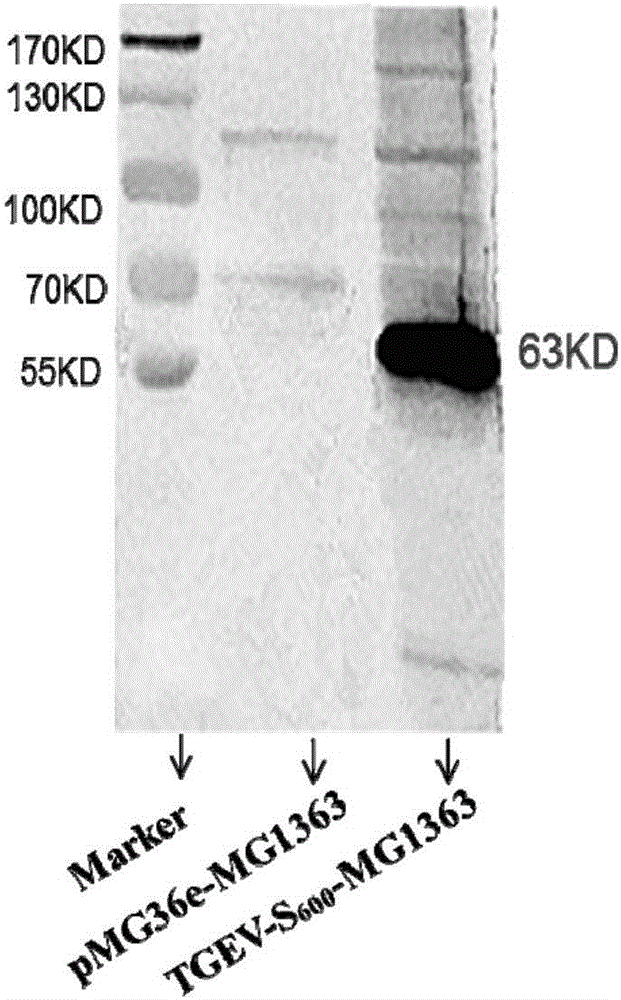Recombinant lactococcus lactis expressing S600 gene of transmissible gastroenteritis virus of pigs and application
A technology of Lactococcus lactis, tgev-s600-pmg36e, applied in recombinant Lactococcus lactis and application fields, can solve the problems of vaccines that cannot reach virus strain attack, waste of manpower, material and financial resources, and unsatisfactory immune effects.
- Summary
- Abstract
- Description
- Claims
- Application Information
AI Technical Summary
Problems solved by technology
Method used
Image
Examples
Embodiment 1
[0074] Synthesis of target genes and primers
[0075] 1. Synthesis of the target gene
[0076] According to the TGEV S gene sequence (ACCESSION: AF494337) published on NCBI, take the gene sequence of 1-1800bp (as shown in SEQ ID NO. 1)
[0077] Codon preference table for Lactococcus lactis MG1363
[0078] Codon Frequency Table Used Lactococcus lactis subsp.Cremoris MG1363
[0079]
[0080] 2. Primer Synthesis
[0081] 2.1. Gene synthesis primers
[0082] A pair of primers were designed according to the gene sequence synthesized by codon optimization (see Sequence Table 1) and the pMG36e vector multiple cloning site, the upstream and downstream were respectively:
[0083] S 600 -P1: GC GTC GAC TAAAAAATTATTTGTTG,
[0084] Sal I
[0085] S 600 -P2:GG GGTACC TTAATCTAAAACATCTG;
[0086] Kpn I
[0087] Restriction endonucleases are Sal Ⅰ and Kpn Ⅰ, respectively. Due to the frame shift phenomenon in the upstream, a base T is added after the Sal Ⅰ restriction site, a...
Embodiment 2
[0096] recombinant vector TGEV-S 600 - Construction of pMG36e
[0097] 1. Amplification of the target gene fragment
[0098] According to the instructions of the plasmid mini-extraction kit, the synthetic S 600 Rapid extraction of gene plasmids and pMG36e vectors
[0099]Amplification of codon-optimized S with Prime-STAR 600 The gene sequence was amplified in 6 tubes in total, 50 μl in each tube, Prime-STAR amplification system:
[0100]
[0101] Prime-STAR amplification reaction procedure:
[0102] Pre-denaturation: 98°C, 2min; denaturation: 98°C, 10sec; annealing: 55°C, 15sec; extension: 72°C, 2min; post-extension: 72°C, 10min; cycle: 30
[0103] After the amplification is completed, add 5.5 μl 10×loading buffer, electrophoresis with 1% agarose gel, cut out the target band and recover the target fragment with a gel recovery kit.
[0104] 2. S 600 Double digestion of gene and pMG36e vector
[0105] Simultaneous digestion of S with two restriction enzymes, Sal Ⅰ and...
Embodiment 3
[0134] recombinant strain TGEV-S 600 - Construction of MG1363 recombinant bacteria
[0135] 1. Preparation of related media and reagents
[0136] SGM17 medium: 10ml M17 medium, 1562μl 50% sucrose, 200μl 50% glucose, 100μl 2mol / LMgCl 2 , 40μl 0.5mol / LCaCl 2 .
[0137] Solution Ⅰ: 84ml M17 medium, 1ml 50% glucose, 10ml 10% glycine, 5ml ddH 2 o
[0138] Solution Ⅱ: 34ml 50% sucrose, 10ml glycerin, 56ml ddH 2 o
[0139] 2. Preparation of MG1363 Lactococcus lactis Competence (Preparation and use now)
[0140] The preparation steps of MG1363 Lactococcus lactis competent are as follows:
[0141] 2.1 Take 50 μl of MG1363 seed solution with a pipette gun, add it to 5ml of sterilized M17 medium, and culture at 30°C for 10 hours;
[0142] 2.2 Inoculate the MG1363 seed solution cultivated for 10 hours into sterilized 15ml Solution I medium with a 2% inoculation amount, and culture it statically at 30°C;
[0143] 2.3 Measure the absorbance of the bacterial solution at a wavelengt...
PUM
 Login to View More
Login to View More Abstract
Description
Claims
Application Information
 Login to View More
Login to View More - R&D
- Intellectual Property
- Life Sciences
- Materials
- Tech Scout
- Unparalleled Data Quality
- Higher Quality Content
- 60% Fewer Hallucinations
Browse by: Latest US Patents, China's latest patents, Technical Efficacy Thesaurus, Application Domain, Technology Topic, Popular Technical Reports.
© 2025 PatSnap. All rights reserved.Legal|Privacy policy|Modern Slavery Act Transparency Statement|Sitemap|About US| Contact US: help@patsnap.com



